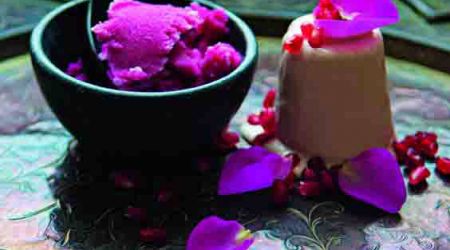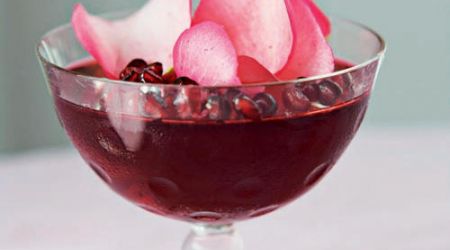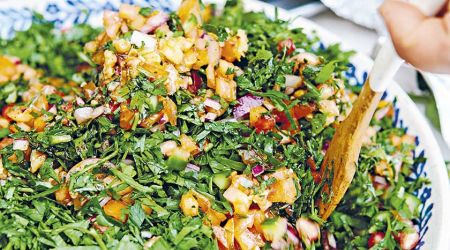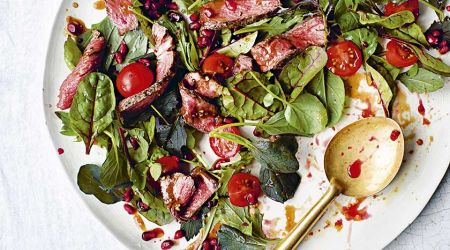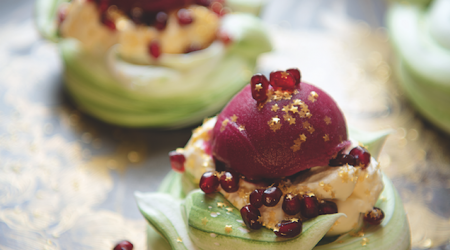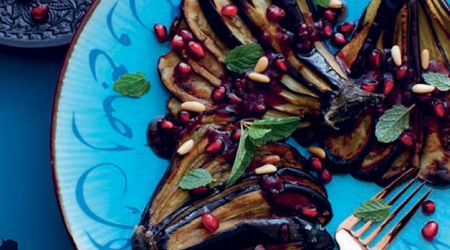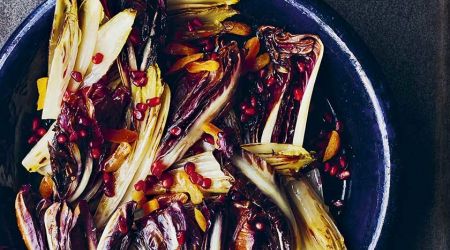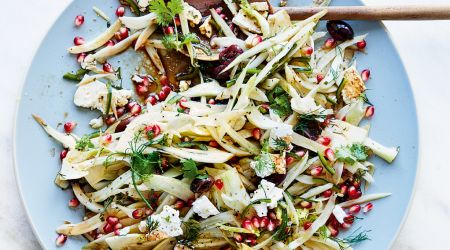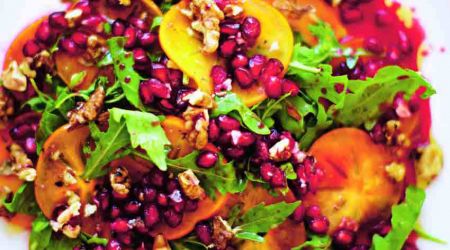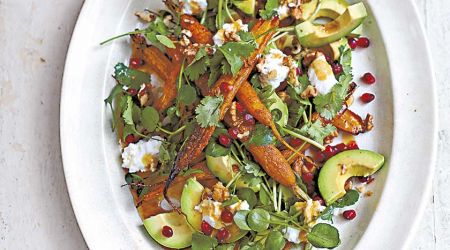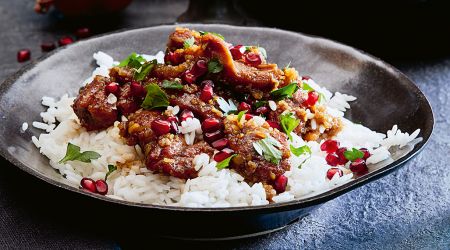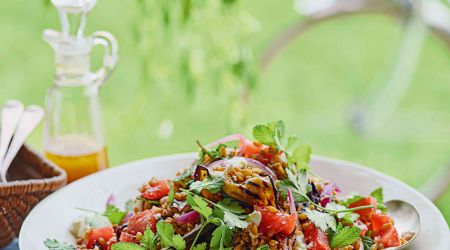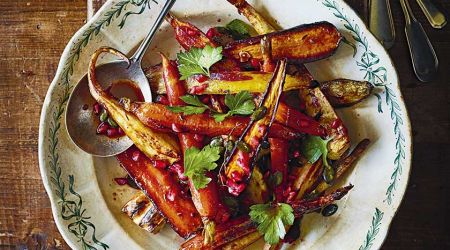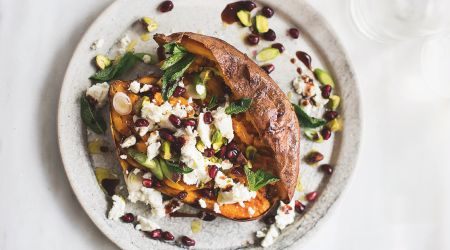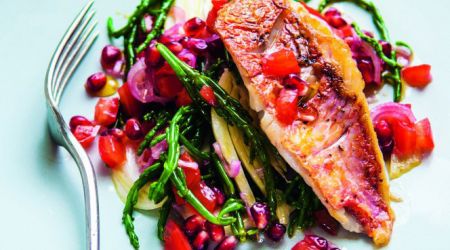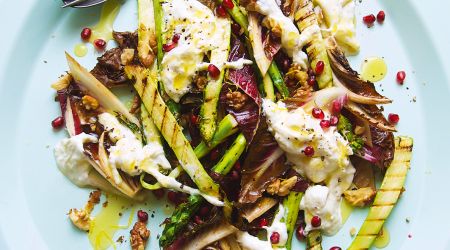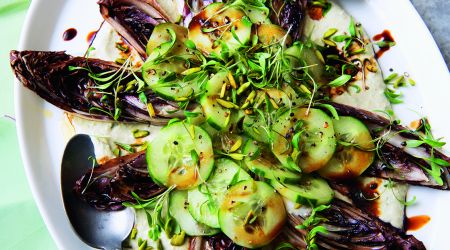Pomegranates
Ancient civilisations revered the pomegranate. Clarissa Hyman believes that, for the rich flavour and vibrant colour the fruit adds to dishes, today’s gourmets should too with recipes by Linda Tubby
If fruits were in fact famous beauties, pomegranates would be Sophia Loren or, perhaps, Cleopatra: dazzling good looks, and an alluring taste and fragrance, but in need of very careful handling.
Few fruits are so rich in cultural resonance and history, yet until relatively recently pomegranates have been neglected in most of Europe. The general view was that, although edible, there were easier things to prepare and enjoy; their value was more decorative than gastronomic. In their ancient homelands, the Middle East and Central Asia, however, pomegranates have great religious and symbolic significance, representing prosperity and fertility, and play an important role in culinary culture.
No one knows for certain where the fruit originated. Afghanistan is a popular candidate but Persia, Armenia and the Caucasus are also contenders. For the ancient peoples of Asia Minor it was as important as the grape and fig. In Persia and Egypt they grew both bitter and sweet varieties. The Old Testament describes the children of Israel remembering with longing the pomegranates of Egypt as they wandered in the wilderness, and when Moses’ scouts returned from Canaan they brought some back with them as proof of the land’s fruitfulness. King Solomon, later, cultivated a grove of pomegranates, and compared his love’s temples to a ‘piece of pomegranate within thy locks.’
The ancient Greeks also prized pomegranates, depicting them in their art and mentioning them in their writings, and believed Zeus created them. Mythology associates the fruit with fertility, especially in the story of Persephone, daughter of Demeter. She was condemned to spend half of each year in the dark after eating six pomegranate seeds in the underworld. The Romans apparently preferred to import them from Carthage, describing them as malum punicum, the Carthaginian apple. Pliny provides details of nine varieties, and Columella gives directions on how to preserve them. The name ‘pomegranate’ derives from pomum granatum, the medieval Latin for ‘seeded apple’. The 12th-century Moorish writer Ibn al-Awwam described ten varieties then being grown in southern Spain. Somewhat later, Shakespeare referred to the pomegranate tree in the famous bird-spotting debate between Romeo and Juliet, which suggests the fruit was available, and familiar, in Britain at the time.
The trees are small with vivid red flowers and branches covered with sharp spines: picking can be painful. They require a very hot, dry summer to thrive and can withstand considerable frost in winter; they resist drought but still need irrigation.
Strikingly handsome with a distinctive crown-shaped calyx, the fruit should feel solid and heavy in the hand. The skin looks like burnished leather and can vary in colour from warm brownish-yellow to deep crimson. When cut in half, the pomegranate reveals a yellow suede-like pith and seeds covered by translucent, jewel-like sacs, called arils. A thin, bitter membrane separates these cells into irregular compartments. The 19th-century poet Elizabeth Barrett Browning noted an unmistakable resemblance. ‘Some pomegranate which, if cut down the middle,’ she wrote, ‘shows a heart within blood-tinctured, of a veined humanity.’
Wild pomegranates tend to be extremely sour and astringent. Cultivated varieties have plenty of juicy pulp and a delicate, sweetsharp flavour that is particularly refreshing in arid, hot countries. The pink-red arils enclose crunchy, white seeds, which can be eaten, or you can suck the aril flesh away from them. Most modern varieties have few seeds or have soft seeds.
Removing the masses of arils from the membrane can take time. To prepare the fruit, cut a thin slice from the crown of the pomegranate, then score the skin lengthways, taking care not to puncture the cells. Bend back each section of skin and winkle out the jelly-like seeds, discarding the pith and membranes. It is easiest to do this with the fruit submerged in a bowl of water because the arils and seeds sink, and the inedible pulp membranes rise.
Sprinkled on Persian and Middle Eastern meat dishes, on couscous and rice, or used in salsas, the cells add both vivid colour and an intense burst of flavour. At Moro in London, yoghurt and pomegranate sauce appears frequently on the menu, especially when they are in season at the end of the year. As the restaurant’s founders Sam and Sam Clark say, it makes anything look ravishing, fish and lamb especially.
Pomegranates are also used to decorate and flavour ice cream and fruit salads. Skye Gyngell makes a fruity winter dessert with clementines, Medjool dates, pomegranates, mascarpone and almonds candied with chestnut honey. The dried seeds of the wild pomegranate or daru, which grows in the lower Himalayas, are an important condiment (anardana) in Indian cooking.
To extract the juice, use the back of a spoon to crush the cells in a sieve placed over a bowl, or gently but firmly press each cut half over a lemon squeezer. Electric squeezers break down the seeds and membrane, and make the juice too bitter.
The juice is used in dishes such as faisinjan, duck or chicken with walnuts and pomegranate juice, in jellies or mixed with gin for a lively cocktail. It makes a superb marinade, adding depth of flavour and colour, and the acidic balance works beautifully with game, turkey and lamb.
Pomegranate syrup or molasses is made by boiling down the juice of sour pomegranates to a thick, dark, brown-red sauce. This has a gloriously concentrated, fruity flavour. Allegra McEvedy uses it in a dish of pot-roast chicken stuffed with bulgar, pine nuts, mince, lemon zest, cumin and cinnamon. Grenadine is sweetened pomegranate syrup that is popular in France and Italy for flavouring long drinks.
Pomegranates may be a gift of the gods but they can also trap the unwary. Beware eating or preparing them while wearing white: the juice, alas, stains indelibly, which rather spoils the Sophia Loren look.

Recipes
Get Premium access to all the latest content online
Subscribe and view full print editions online... Subscribe



